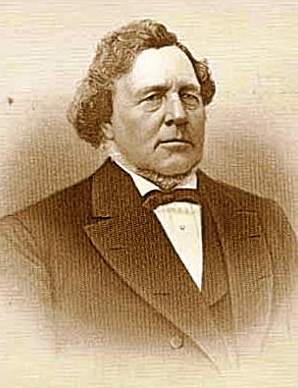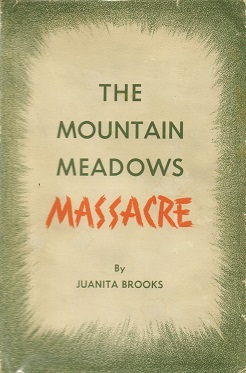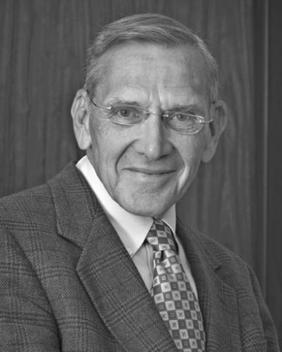The Mountain Meadows Massacre was a series of attacks during the Utah War that resulted in the mass murder of at least 120 members of the Baker–Fancher emigrant wagon train. The massacre occurred in the southern Utah Territory at Mountain Meadows, and was perpetrated by settlers from the Church of Jesus Christ of Latter-day Saints involved with the Utah Territorial Militia who recruited and were aided by some Southern Paiute Native Americans. The wagon train, made up mostly of families from Arkansas, was bound for California, traveling on the Old Spanish Trail that passed through the Territory.

George Albert Smith was an early leader in the Latter Day Saint movement. He served in the Quorum of the Twelve Apostles and as a member of the First Presidency of the Church of Jesus Christ of Latter-day Saints.

The Baker–Fancher party was a group of American western emigrants from Marion, Crawford, Carroll, and Johnson counties in Arkansas, who departed Carroll County in April 1857 and "were attacked by the Mormons near the rim of the Great Basin, and about fifty miles from Cedar City, in Utah Territory, and that all of the emigrants, with the exception of 17 children, were then and there massacred and murdered" in the Mountain Meadows massacre. Sources estimate that between 120 and 140 men, women and children were killed on September 11, 1857, at Mountain Meadows, a rest stop on the Old Spanish Trail, in the Utah Territory. Some children of up to six years old were taken in by the Mormon families in Southern Utah, presumably because they had been judged to be too young to tell others about the massacre.
Mormons have both used and been subjected to significant violence throughout much of the religion's history. In the early history of the United States, violence was used as a form of control. Mormons were violently persecuted and pushed from Ohio to Missouri, from Missouri to Illinois and from Illinois, they were pushed west to the Utah Territory. There were incidents of massacre, home burning and pillaging, followed by the death of their prophet, Joseph Smith. Smith died from multiple gunshot wounds from a lynch mob at a jail in Carthage, Illinois; Smith had defended himself with a small pistol smuggled to him by church leader Cyrus Wheelock and he was then shot while trying to flee from a window. There were also notable incidents in which Mormons perpetrated violence. Under the direction of Mormon prophets and apostles, the Mormon burned and looted Davies County, attacked and killed a member of the Missouri state militia, and carried out an extermination order on the Timpanogos. Other Mormon leaders led the Mountain Meadows Massacre, Battle Creek massacre, and Circleville Massacre. Mormons have also been a major part in several wars, including the 1838 Mormon War, Walker War and Black Hawk War.
Although the Mountain Meadows massacre was covered to some extent in the media during the 1850s, its first period of intense nationwide publicity began around 1872. This was after investigators obtained the confession of Philip Klingensmith, a Mormon bishop at the time of the massacre and a private in the Utah militia. National newspapers also covered the John D. Lee trials closely from 1874 to 1876, and his execution in 1877 was widely publicized. The first detailed work using modern historical methods was published in 1950, and the massacre has been the subject of several historical works since that time.
Tutsegabit was a 19th-century leader of the Piede (Chemehuevi) bands of the Paiute tribe.

Kanosh was a nineteenth-century leader of the Pahvant band of the Ute Indians of what is now central Utah having succeeded the more belligerent Chuick as principal chief. His band had "a major camp at Corn Creek." He is remembered for having been "friendly toward early Mormon Pioneer settlers."
The Mountain Meadows Massacre was caused in part by events relating to the Utah War, an armed confrontation in Utah Territory between the United States Army and Mormon Settlers. In the summer of 1857, however, Mormons experienced a wave of war hysteria, expecting an all-out invasion of apocalyptic significance. From July to September 1857, Mormon leaders prepared Mormons for a seven-year siege predicted by Brigham Young. Mormons were to stockpile grain, and were prevented from selling grain to emigrants for use as cattle feed. As far-off Mormon colonies retreated, Parowan and Cedar City became isolated and vulnerable outposts. Brigham Young sought to enlist the help of Indian tribes in fighting the "Americans", encouraging them to steal cattle from emigrant trains, and to join Mormons in fighting the approaching army.
Mormon theology has long been thought to be one of the causes of the Mountain Meadows Massacre. The victims of the massacre, known as the Baker–Fancher party, were passing through the Utah Territory to California in 1857. For the decade prior the emigrants' arrival, Utah Territory had existed as a theocracy led by Brigham Young. As part of Young's vision of a pre-millennial "Kingdom of God," Young established colonies along the California and Old Spanish Trails, where Mormon officials governed as leaders of church, state, and military. Two of the southernmost establishments were Parowan and Cedar City, led respectively by Stake Presidents William H. Dame and Isaac C. Haight. Haight and Dame were, in addition, the senior regional military leaders of the Mormon militia. During the period just before the massacre, known as the Mormon Reformation, Mormon teachings were dramatic and strident. The religion had undergone a period of intense persecution in the American mid-west.
The pursuit of the perpetrators of the Mountain Meadows massacre, which atrocity occurred September 11, 1857, had to await the conclusion of the American Civil War to begin in earnest.
The conspiracy and siege of the Mountain Meadows Massacre was initially planned by its Mormon perpetrators to be a short "Indian" attack, against the Baker–Fancher party. But the planned attack was repulsed and soon turned into a siege, which later culminated in the massacre of the remaining emigrants, on September 11, 1857.
The Mountain Meadows massacre was a series of attacks on the Baker–Fancher emigrant wagon train, at Mountain Meadows in southern Utah. The attacks culminated on September 11, 1857 in the mass slaughter of the emigrant party by the Iron County district of the Utah Territorial Militia and some local Indians.
William Grant Bagley was a historian specializing in the history of the Western United States and the American Old West. Bagley wrote about the fur trade, overland emigration, American Indians, military history, frontier violence, railroads, mining, and Utah and the Mormons.

The Mountain Meadows Massacre (1950) by Juanita Brooks was the first definitive study of the Mountain Meadows Massacre.

American Massacre: The Tragedy At Mountain Meadows, September 1857 is a non-fiction historical book by investigative reporter and author Sally Denton, released by Alfred A. Knopf in 2003.
Richard Eyring "Rick" Turley Jr. is an American historian and genealogist. He previously served as both an Assistant Church Historian of the Church of Jesus Christ of Latter-day Saints and as managing director of the church's public affairs department.
In 1857, at the time of the Mountain Meadows Massacre, Brigham Young, was serving as President of the Church of Jesus Christ of Latter-day Saints and as Governor of Utah Territory. He was replaced as governor the following year by Alfred Cumming. Evidence as to whether or not Young ordered the attack on the migrant column is conflicted. Historians still debate the autonomy and precise roles of local Cedar City LDS Church officials in ordering the massacre and Young's concealing of evidence in its aftermath. Young's use of inflammatory and violent language in response to a federal expedition to the territory added to the tense atmosphere at the time of the attack. After the massacre, Young stated in public forums that God had taken vengeance on the Baker–Fancher party. It is unclear whether Young held this view because of a possible belief that this specific group posed a threat to colonists or that they were responsible for past crimes against Mormons. According to historian William P. MacKinnon, "After the war, Buchanan implied that face-to-face communications with Brigham Young might have averted the Utah War, and Young argued that a north–south telegraph line in Utah could have prevented the Mountain Meadows Massacre."

Ronald Warren Walker was an American historian of the Latter Day Saint movement and a professor at Brigham Young University (BYU) and president of the Mormon History Association. His work, acclaimed by the Mormon History Association, dealt with the Godbeites, the Utah War, and the Mountain Meadows Massacre, among other topics.
Robert H. Briggs is a Fullerton, California, lawyer and independent historian. As of 2010, Briggs's area of historical research related to violence in frontier Utah, in particular the Mountain Meadows Massacre of 1857.
Mormon studies is the interdisciplinary academic study of the beliefs, practices, history and culture of individuals and denominations belonging to the Latter Day Saint movement, a religious movement associated with the Book of Mormon, though not all churches and members of the Latter Day Saint movement identify with the terms Mormon or Mormonism. Denominations of the Latter Day Saint movement include the Church of Jesus Christ of Latter-day Saints, by far the largest, as well as the Community of Christ (CoC) and other smaller groups, include some categorized under the umbrella term Mormon fundamentalism.







